Western Digital Blue SN550 1TB Review - Monster Mainstream
A review of the 1TB Western Digital Blue SN550 M.2 PCIe NVMe SSD Using Testbed v1.0 and Methodology v1.0.
Jan 26, 2021
- Benjamin Wachman
Tags:
#Methodology-v1
#Testbed-v1
#SSD
#NVMe
#TLC
For those of you familiar with Western Digital (WD) and their products over the years, you’ll know that they use the Blue branding to signify their mainstream (rather than low-end or high-end) products. They’ve been using this nomenclature for YEARS starting with spinning disk drives before applying it to SATA SSDs and now NVMe SSDs. This is Western Digital’s second NVMe drive to bear the Blue moniker, hence the “SN550” descriptor. This model is a moderate step up from the first generation NVMe Blue drive. Despite claiming to offer mainstream performance, the drive is a DRAMless design which is often relegated to lower-tier drives.
Also note, WD aquired SanDisk back in 2016 and has slowly been melding the two companies’ product stacks. Though this drive is sold under the WD brand, the major components (NAND and Controller) both bear the SanDisk name.
Before I get too far, if you want to know more about how I perform the tests in this review, check out my first blog post: SSD Review Background, Setup, and Methodology v1.0. My first round of reviews will all use the same Testbed and Methodology, so will be directly comparable.
The Drive:
Western Digital Blue SN550 1TB
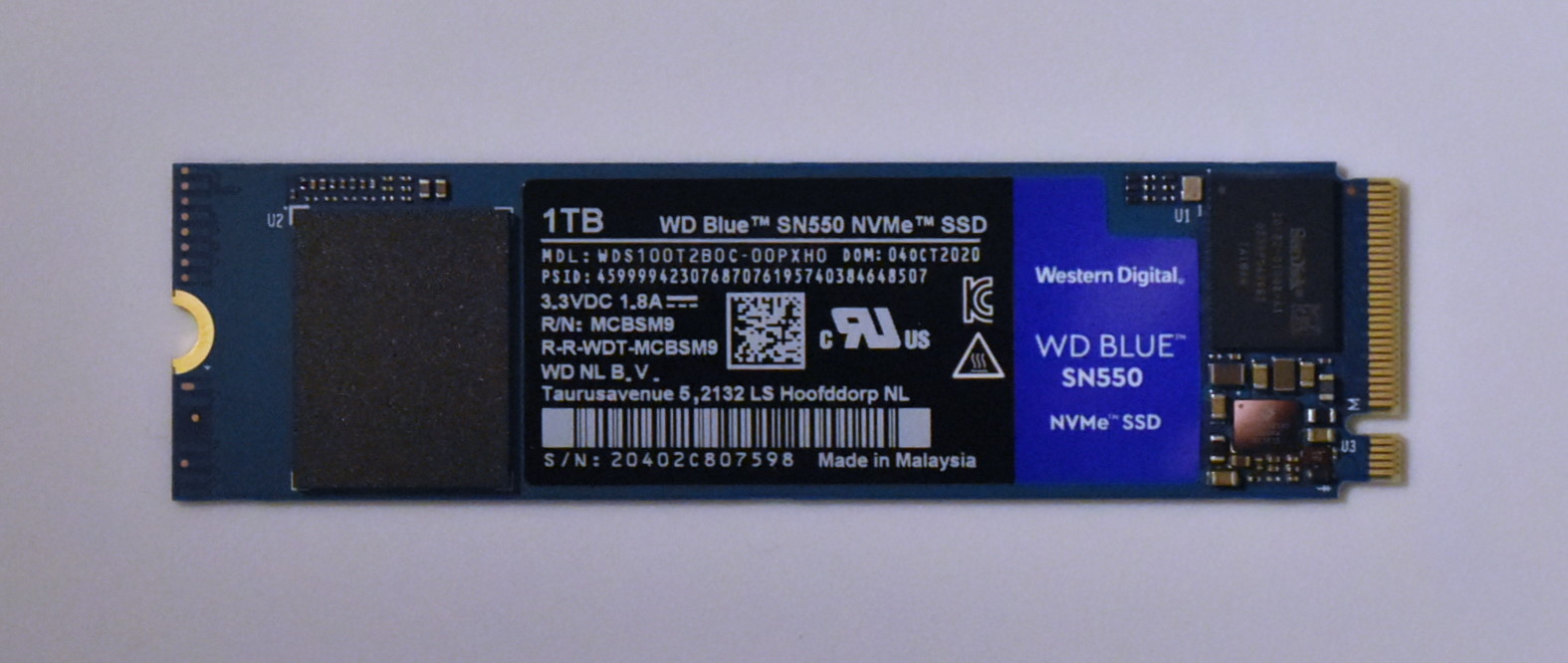 Western Digital uses an in-house SanDisk controller with a DRAMless design and some TLC 3D NAND.
Western Digital uses an in-house SanDisk controller with a DRAMless design and some TLC 3D NAND.
| The Drive - Table of Specifications | |
|---|---|
| Western Digital Blue SN550 1TB | |
| M.2 Dimensions | 2280 |
| Capacity | 1000GB |
| Interface | PCIe 3.0 x4 |
| NVMe Protocol | 1.4 |
| Seq Read | 2400 MB/s |
| Seq Write | 1950 MB/s |
| I/O Read | 410K |
| I/O Write | 405K |
| Active Power | 3.5W |
| Idle Power | 3mW(PS4)/30mW(PS3) |
| Components | In-House DRAMless Controller + 1 NAND Package |
| NAND | SanDisk 96-layer 3D TLC |
| Rated Endurance | 600TBW |
| Retail/OEM Drive | Retail |
| Cost Today | $95 |
Review
For the graphs in this review I’m using the 128GB Kioxia BG4 to represent small, entry-level NVMe drives, the 1TB Toshiba XG6 as a moderately high-end PCIe 3.0 NVMe drive, and the Samsung 860 EVO and PM871b to round out the comparison with both premium and low-end SATA drives. As noted in my other reviews thus far, all drives have been evaluated using my v1 Testbed and Methodology and as such the results are directly comparable. Check out my other #Methodology-v1 reviews if you’d like to compare the results to other drives I’ve tested so far.
In case you didn’t catch my note at the top, if you’d like to know more about my hardware setup as well as my testing methodology, check out my SSD Review Background, Setup, and Methodology v1.0 piece.
Write Test — Disk Fill Summary
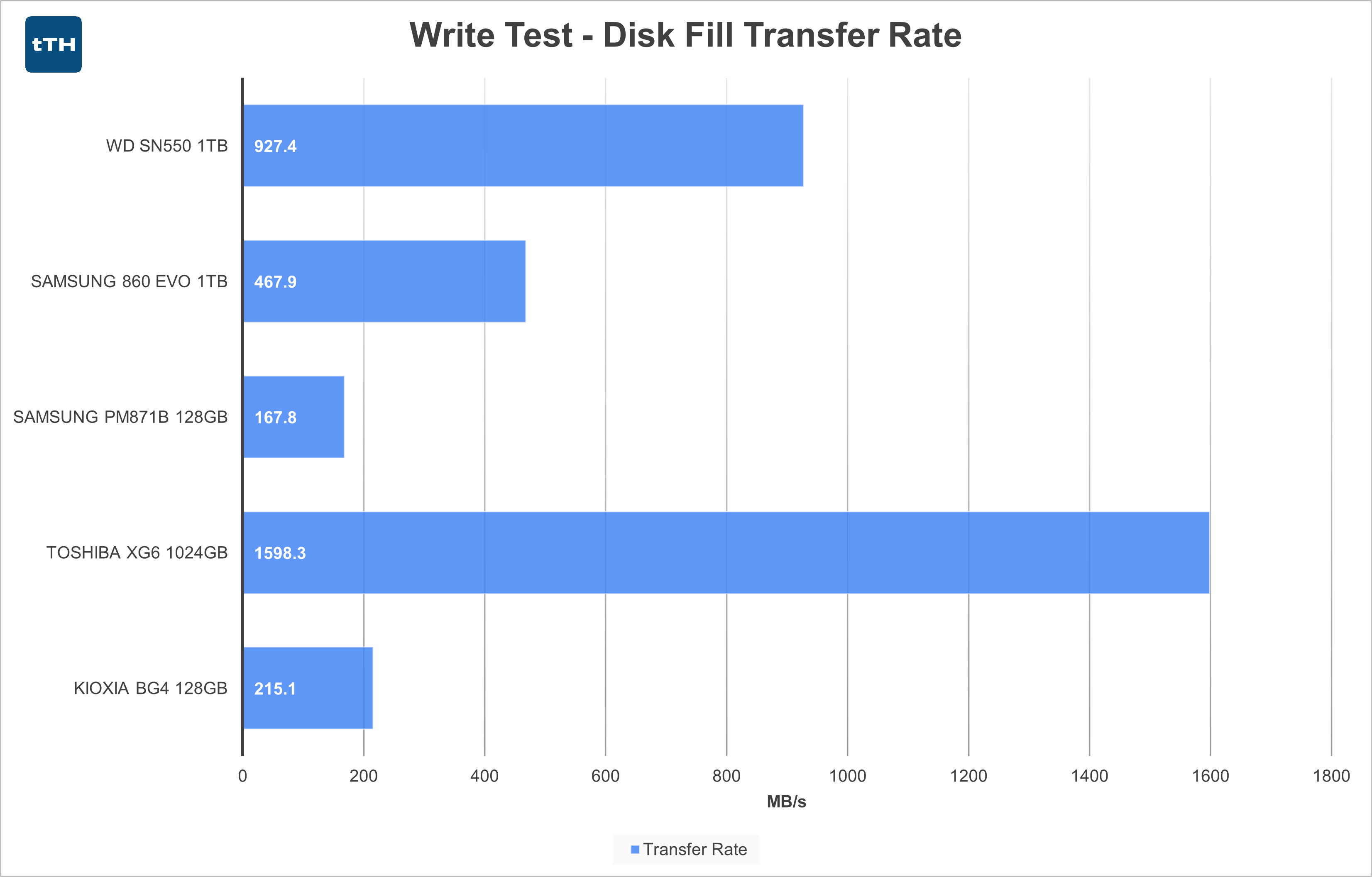
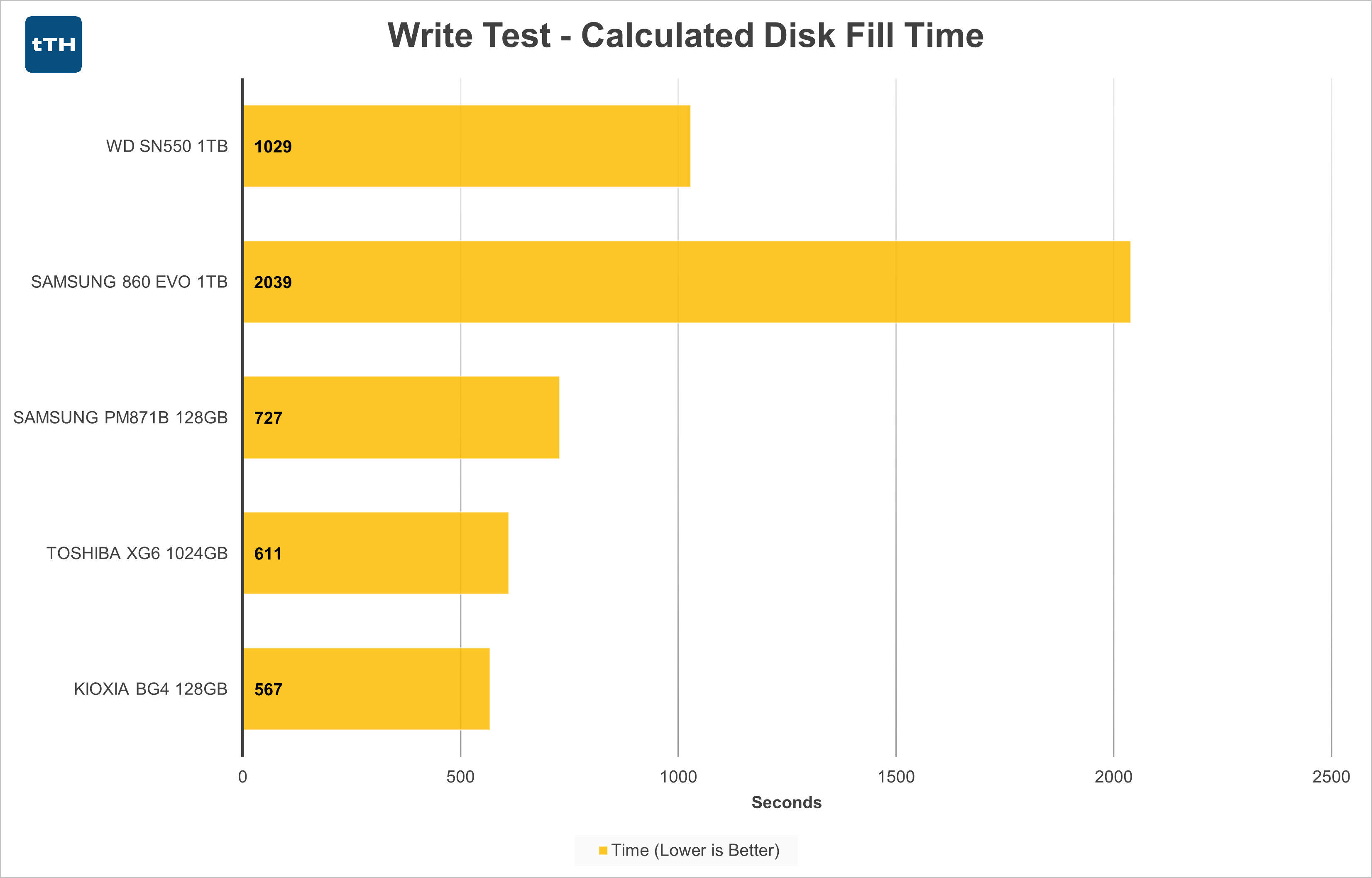 Right away, we see the 1TB SN550 performing head-and-shoulders above the top-tier SATA SSDs and entry-level NVMe drives in the Disk Fill test. It falls behind the upmarket 1TB XG6 by a considerable margin, (but as will likely become a repeating refrain in this review) that is to be expected.
Right away, we see the 1TB SN550 performing head-and-shoulders above the top-tier SATA SSDs and entry-level NVMe drives in the Disk Fill test. It falls behind the upmarket 1TB XG6 by a considerable margin, (but as will likely become a repeating refrain in this review) that is to be expected.
Write Test — Disk Fill
WD Blue SN550 1TB
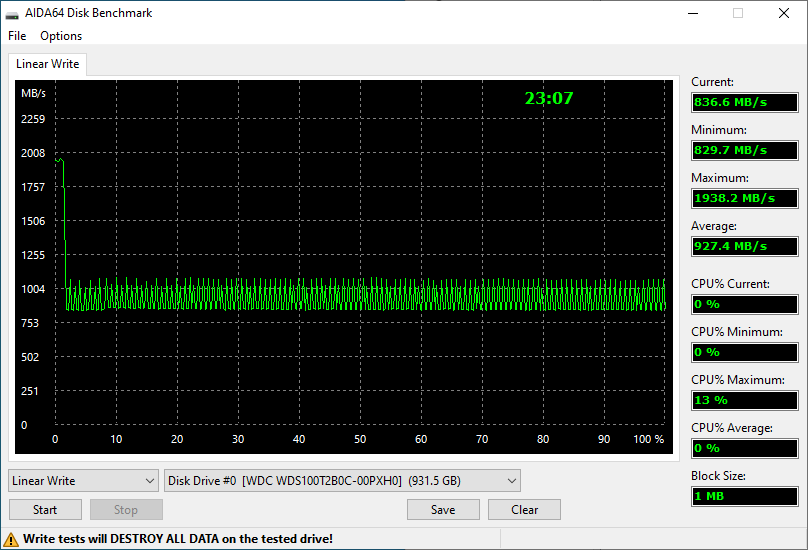 The SN550 starts off writing at just under 2000MB/s but then quickly falls by more than half to somewhere in the neighborhood of 900MB/s after it exhausts its relatively small SLC cache. Still, this reduced speed is almost double what even the best SATA SSDs are capable of. The drive doesn’t maintain quite as high write speed across the entire drive capacity like the XG6, trailing it by 45%, but this is also many times better performance than most of the low-end drives in the entry-level NVMe roundup.
The SN550 starts off writing at just under 2000MB/s but then quickly falls by more than half to somewhere in the neighborhood of 900MB/s after it exhausts its relatively small SLC cache. Still, this reduced speed is almost double what even the best SATA SSDs are capable of. The drive doesn’t maintain quite as high write speed across the entire drive capacity like the XG6, trailing it by 45%, but this is also many times better performance than most of the low-end drives in the entry-level NVMe roundup.
AS-SSD Sequential Tests
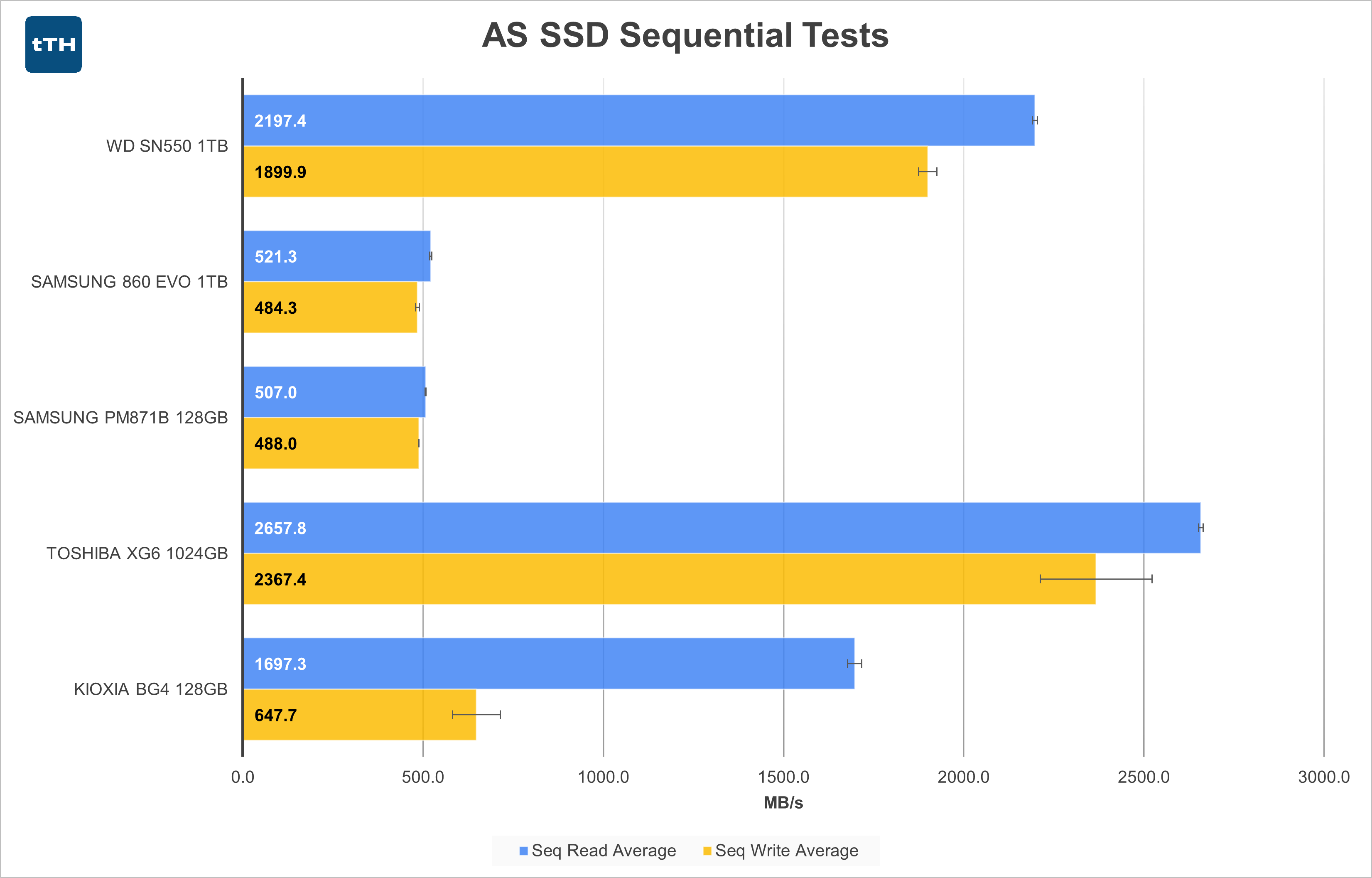 In terms of peak performance testing just 1GB of writes and reads, the SN550 posts impressive figures. It doesn’t quite catch up to the 1TB XG6, but it isn’t too far off either, trailing by 17% for reads and 20% for writes. The SATA drives and the slower NVMe drives are left far behind by a factor of ~4x.
In terms of peak performance testing just 1GB of writes and reads, the SN550 posts impressive figures. It doesn’t quite catch up to the 1TB XG6, but it isn’t too far off either, trailing by 17% for reads and 20% for writes. The SATA drives and the slower NVMe drives are left far behind by a factor of ~4x.
AS-SSD 4K Tests
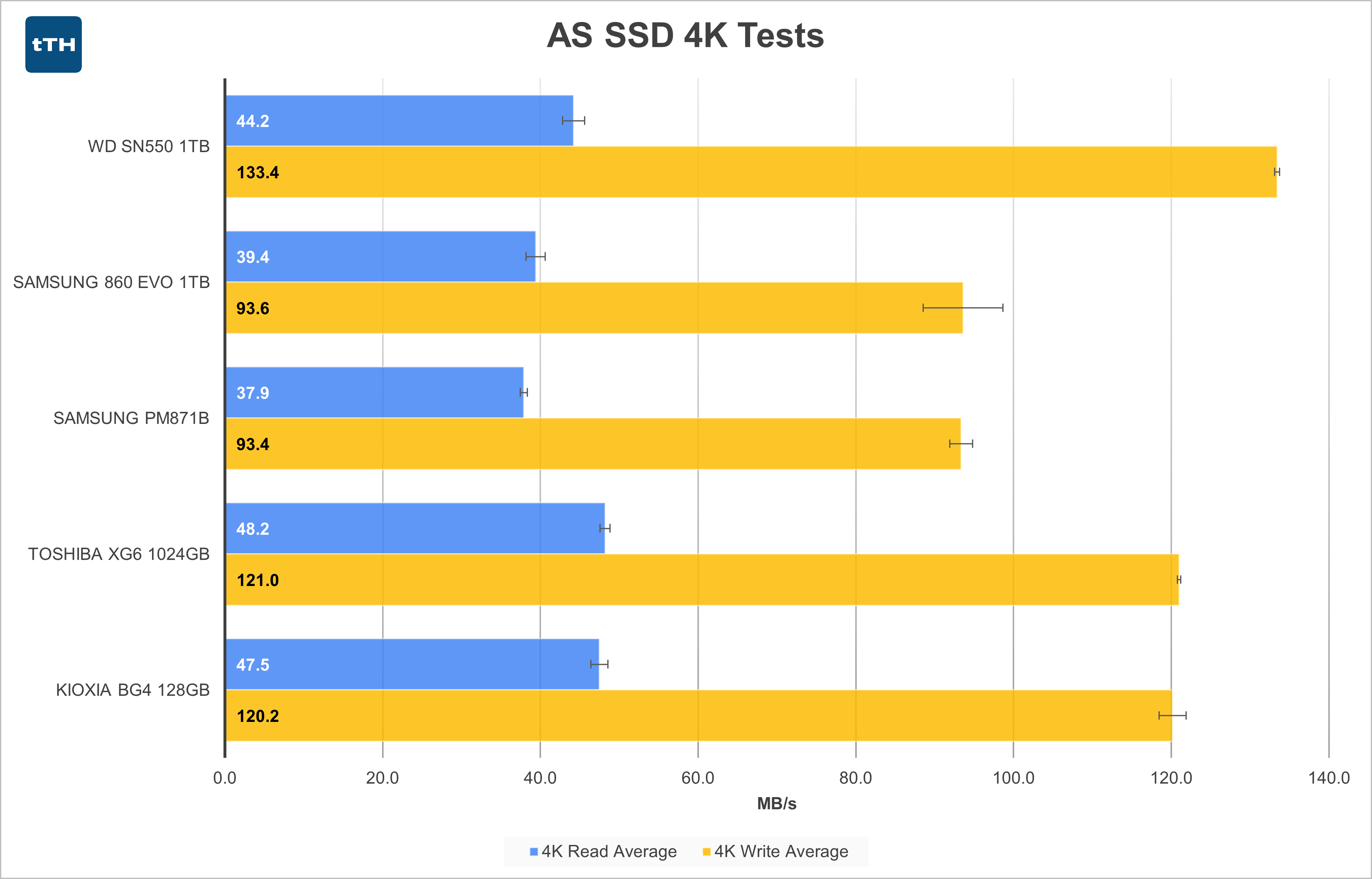 For 4K reads, the 1TB SN550 achieved 44.2MB/s. This puts its performance in the slightly-faster tier along with the other NVMe drives, but ends up being the slowest of the bunch by a small margin. On the other hand, its 4K write performance leads the pack, even outperforming the XG6 by 11%.
For 4K reads, the 1TB SN550 achieved 44.2MB/s. This puts its performance in the slightly-faster tier along with the other NVMe drives, but ends up being the slowest of the bunch by a small margin. On the other hand, its 4K write performance leads the pack, even outperforming the XG6 by 11%.
PCMark 8 Storage Test
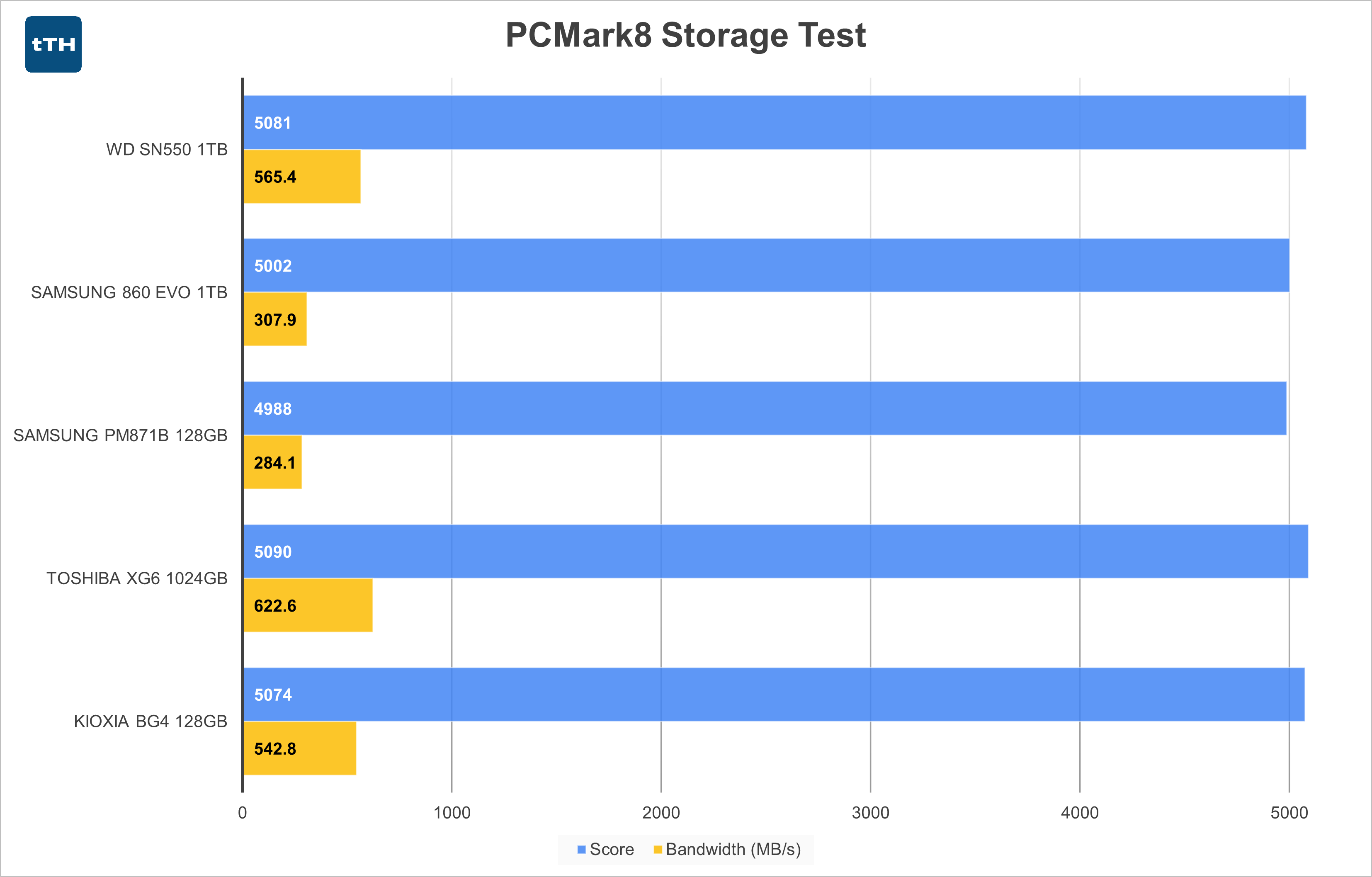 The SN550’s Score and Bandwidth numbers are only slightly higher than those of the BG4, indicating that at least for the applications this somewhat out-of-date real-world test uses, the SN550 won’t perform that much better than a low-end NVMe drive, despite posting much higher values in some of the other metrics. That said, it is only 9% slower than the XG6. Bandwidth numbers are significantly higher than the SATA drives, but as shown in previous reviews the scores don’t reflect this difference to-scale.
The SN550’s Score and Bandwidth numbers are only slightly higher than those of the BG4, indicating that at least for the applications this somewhat out-of-date real-world test uses, the SN550 won’t perform that much better than a low-end NVMe drive, despite posting much higher values in some of the other metrics. That said, it is only 9% slower than the XG6. Bandwidth numbers are significantly higher than the SATA drives, but as shown in previous reviews the scores don’t reflect this difference to-scale.
Large-File Transfer Tests
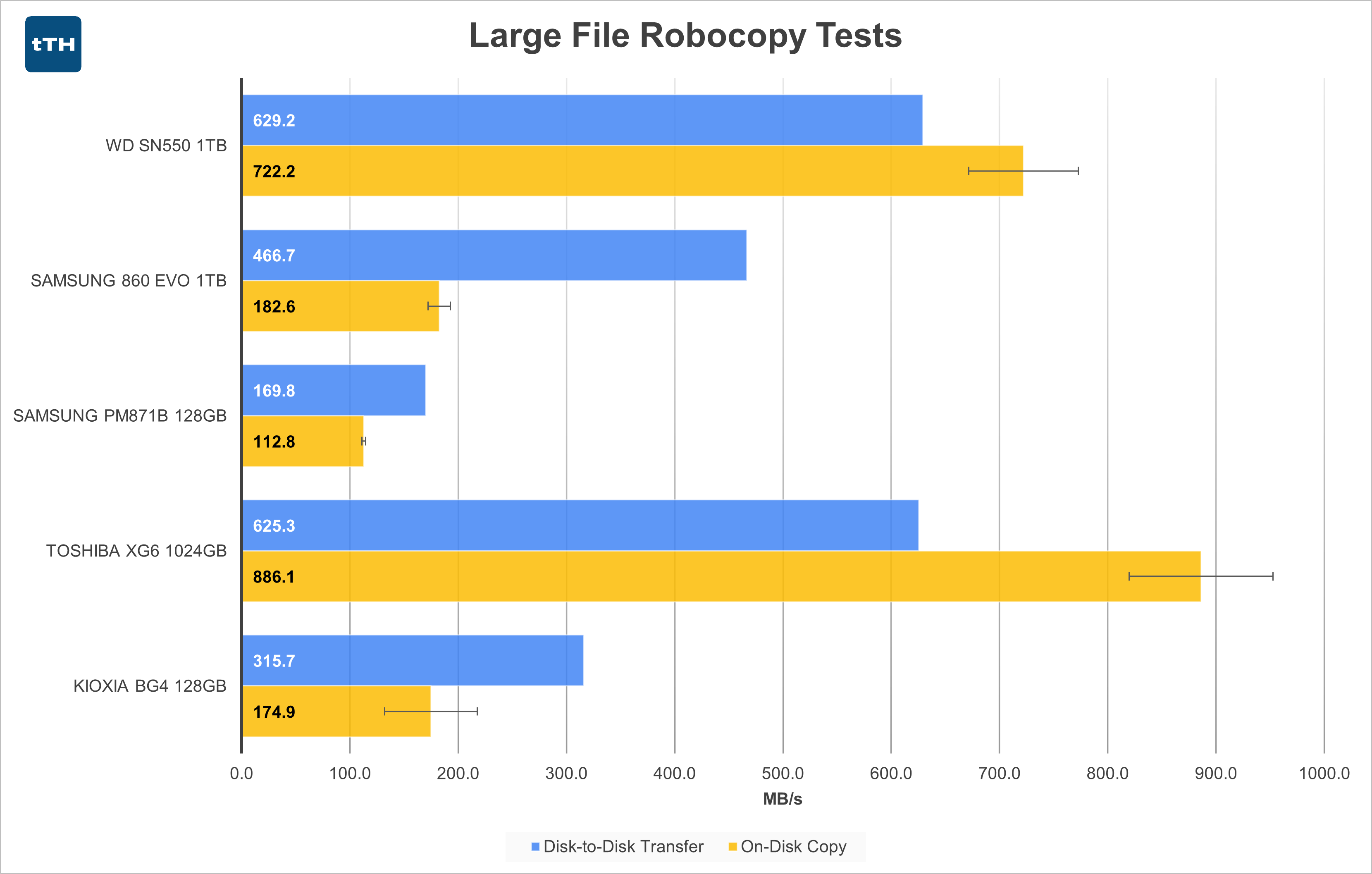 In case the disk-to-disk transfer numbers look a bit odd for the faster NVMe drives, recall that this test is a mostly sequential 30GB transfer from a read-source that peaks at 750MB/s.
In case the disk-to-disk transfer numbers look a bit odd for the faster NVMe drives, recall that this test is a mostly sequential 30GB transfer from a read-source that peaks at 750MB/s.
For the disk-to-disk copy of large files, the SN550 ranks nearly the same as the XG6, both bottlenecked by the read speed of the source disk in this iteration of the testbench. On-disk copy performance exceeds that of the disk-to-disk operation. Despite the disk being busy both reading and writing, this demonstrates that the disk is capable of higher write speeds.
The SN550 is outclassed by the XG6 by a relatively significant 23% margin and also outperforms the other disks in the comparison by a wide margin.
Small-File Transfer Tests
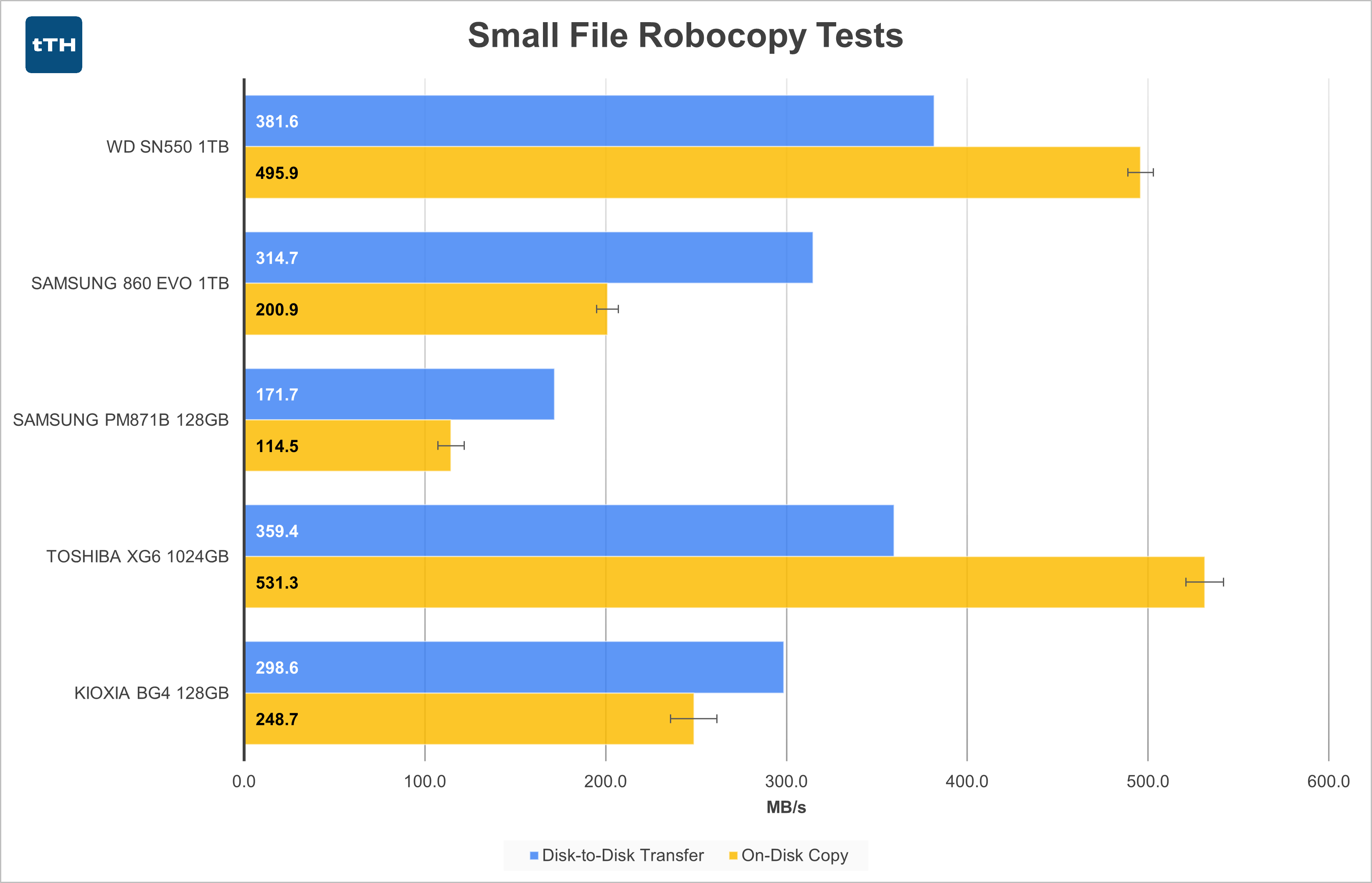 The SN550 performs nearly on-par with the XG6 in this test. Disk-to-disk transfer performance is still bottlenecked, but to a lesser degree than in the large-file test. Both read and write speeds are significantly lower in the small-file tests compared to the large-file tests.
The SN550 performs nearly on-par with the XG6 in this test. Disk-to-disk transfer performance is still bottlenecked, but to a lesser degree than in the large-file test. Both read and write speeds are significantly lower in the small-file tests compared to the large-file tests.
Conclusion
The SN550 performs pretty well considering its entry-level price. There are certainly less expensive drives available, but many of them are inferior implementations of a DRAMless design or use QLC NAND (Intel 660p review coming soon), and as such deliver performance that is inferior to the SN550 in many regards. On the flip-side, there are also higher performing drives available, but in many cases there is also a considerable price premium. For example, the top tier 1TB 970 EVO Plus is currently selling for $156, a 64% price premium. The 970 EVO Plus definitely offers higher performance, but for many users (especially those on a budget) is probably not the best investment.
Unless you absolutely need the best storage performance – say for editing raw video or something in the vein of database applications – then the SN550 drive is probably a “good enough” drive for most users. If you DO need the hightest tier of performance, then there are other more premium drives available including the 970 EVO Plus and current and soon to be released PCIe 4.0 drives.
Additionally, even though I’m not set up to test power draw, I know from reading elsewhere that the SN550 has exceptionally good power efficiency due to its lack of DRAM (power savings) and moderately high performance making it well-suited for mobile use, either in an external enclosure or a laptop.
For now, the SN550 provides a great balance between price and performance and is definitely a drive I’d recommend.